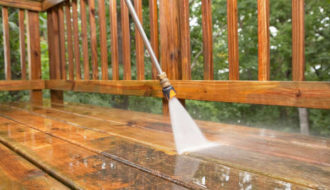Leaving wood to dry and the stain to cure is one of the longest parts of deck staining, but also one of the most critical. Once you have cleaned your deck, letting wood fully cure is all the more important to let before you stain or paint. Stains take time to soak into the wood before they fully cure, so avoid painting the deck under direct sunlight.
You should take care of the task of applying a fresh coat of stain every few years to protect your wood and make sure that it looks its best. If you are keeping it in the same color and good shape, a DIY deck cleaning can be all that is needed to prepare your wood for the new coat of stain. One of the best ways to keep a wooden deck looking good is to keep the surface protected with a good coat of stain or paint every so often.
If you want to keep enjoying your wood deck, you have got to keep it well taken care of, and one of the best ways to do this is by applying a good stain coat every 2-3 years, or whenever needed. If your deck is made from pressure-treated wood, it needs some time for the chemicals to cure before it can take stain well. You want to make sure your deck is completely dry before adding a stain, as you do not want to trap any moisture in the wood, which could cause it to rot.
Rotted wood cannot be stained because it will not retain the stain, and simply, will not last as long. The drawback is that full-stack staining does not reveal wood grain as detail because it covers up more like paint. Full solid and semi-full staining may also overshadow wood in your deck unless it is a wood known for beauty like Green Treated Wood.
If you leave the surface of your deck exposed, drippings and runs show even when sprayed all over. If there are minor spots of stain that do not clean off in the cleanup process, then the palm-style wood finisher should be able to remove them easily once your old deck has dried. If the deck has built up an older stain, the removal gets a bit more difficult, but it is not impossible. If you are re-staining an older deck that has existing stains, then you need to sand down all of the peeled stains, if you stain on top of old peeled stains, then newer layers end up just peeping right out.
Once you sand the wood, the best place to begin staining is at your deck railings or higher sections. Before staining the new deck once weathered, you will want to remove any fibers that are damaged by the sun, mud, and mildew.
If you do not properly clean and prepare the deck, you will run into adhesion problems with the new stain, reducing the lifespan of the stain on the deck. More important than just making your deck coating look good is the fact that staining and sealing your deck helps to protect your deck against harsh UV light and the moisture of the sun, which both will reduce the lifespan of the outer wood. Staining your deck highlights the natural beauty of wood, adding color and highlighting graining within the wood. Staining can revitalize older woods with a new look or can change the tone of wood in your deck so that it is more appropriate for your decor.
Using a paint sprayer can not only help you achieve an excellent staining job on decking, but it can also reduce the time you spend on staining by half. A sprayer also applies a thinner, more uniform layer of stain, meaning that you will use less stain and achieve an impeccable finish. Deck cleaning also helps get rid of any mildew in your deck boards and helps create a blank canvas in your decking so that it is ready to take stain. Not only is pressure washing super fun (and satisfying), it is essential for cleaning up the wood surfaces to allow them to fully and evenly absorb the stain.
Staining your wood is pretty easy, and the process depends on what kind of stain you are using (see the bottom of the page). Professional woodworkers sometimes coat a clear coat on top of stained wood to create a shiny finish. You may wish to use a pre-staining conditioner to make sure that your wood is easily accepting of the stain, as some types of untreated wood soak up finish and you end up using more than you need.
Yes, you are going to be tempted to use a roller – it is much faster to coat the whole area with a roller versus painting by hand – but a brush will work better at getting your stain in the woodgrain. I like using the Deck Staining Pads rather than rollers, as they are a lot easier to reach around corners and edges.
In this case, you might need to use a brush to reach joints, swab off the stain from surfaces when they are damp, and then use a pad applicator to apply it to the deck surfaces themselves. You should wait at least two days after your last rain, or once your deck has been cleaned, before applying your first layer of stain. When staining the exterior rails and joists, you will want to use your smallest deck brush, and try to avoid spraying on your deck boards.









